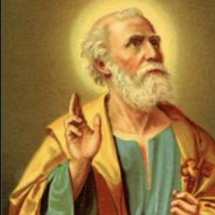There are six houses associated with the following saints. You can read their stories below.
- Green: St Bernadette
- Red: St Kolbe
- Yellow: Oscar Romero
- Blue: Mother Teresa of Calcutta
- Purple: St Peter
- Orange: St Catherine of Siena
St. Bernadette
St. Bernadette Soubirous was born in 1844 to a poor family in Lourdes, France. In 1858 she was visited by an apparition of the Virgin Mary eighteen times in the Grotto near the river. Our Lady told Bernadette that a church should be built there and that people should come in procession to Lourdes and to bathe in the waters of the spring in the Grotto. Mary said of herself “I am the Immaculate Conception.” The solemn dogma that Mary was free of the stain of original sin from the moment of her conception was at that time only recently defined by Blessed Pius IX in 1854. Bernadette was received into the religious order of the Sisters of Charity and lived in their convent in Nevers. She died in 1879 at the age of thirty-five. She was canonised on 8th December, the Feast of the Immaculate Conception, in 1933 by Pope Pius XI. St. Bernadette’s incorrupt body lies in the convent chapel of Nevers.

St. Kolbe
St. Maximilian Kolbe was born in Poland in 1894. Maximilian Kolbe became a Conventual Franciscan friar who was active in promoting the veneration of the Immaculate Virgin Mary. When the Nazis overran the country in 1939, they eventually imprisoned Kolbe in the Auschwitz death camp, where in 1941 he offered to take the place of a man condemned to die in reprisal for an escaped prisoner. His offer accepted, he died two weeks later on 14th August, the vigil of Mary’s Assumption. In the process, he ministered to nine others dying with him from starvation. In 1982, Pope St. John Paul II canonised him as a “martyr of charity” and declared him “the Patron Saint of our difficult century.”

St. Oscar Romero
St. Oscar Romero was born on August 15, 1917. He was born into a large family of five other brothers and sisters. Oscar’s father was a carpenter. When he left school, his father had planned for him to be a carpenter. Oscar had other ideas. Oscar wanted to continue to go to higher levels of education. As a little boy Oscar felt God was calling him to live his life in the service of others so eventually he went to a seminary, a college for training priests. His father tried to convince Oscar to stay with him but he eventually let Oscar go to fulfil his own dreams.
As a priest Oscar served his parish community which had both rich and poor people in it. His country El Salvador was ruled by a military government who used violence to keep the poor, poor and the very wealthy, wealthy.
Oscar spoke out on behalf of the poor. He ignored the death threats from the military in his fight for justice. Then on 24 March 1980, whilst saying Mass in his church, he was assassinated.
To the citizens of El Salvador, Oscar Romero was a martyr.


St. Teresa
St. Teresa was born Agnes Gonxha Bojaxhiu in Macedonia in 1910. Her family was of Albanian descent. At the age of eighteen she left her parental home in Skopje and joined the Sisters of Loreto, an Irish community of nuns with missions in India. Teresa taught at St. Mary’s High School in Calcutta, but the suffering and poverty she glimpsed outside the convent walls made such a deep impression on her that in 1948 she received permission from her superiors to leave the convent school and devote herself to working among the poorest of the poor in the slums of Calcutta. In 1950, Mother Teresa received permission from the Holy See to start her own order, “The Missionaries of Charity”, whose primary task was to love and care for those persons nobody was prepared to look after. They provide effective help to the poorest of the poor in a number of countries in Asia, Africa, and Latin America, and they undertake relief work in the wake of natural catastrophes such as floods, epidemics, and famine, and for refugees. In 1979 Teresa was awarded the Nobel Peace Prize. Teresa died in 1997 and was canonised by Pope Francis in 2016.

St. Peter
St. Peter was born at Bethsaida, near the Sea of Galilee. Peter, whose name was originally Simon, was a fisherman along with his brother Andrew. The Gospels show Peter as the foremost apostle in declaring faith in him as the Christ. The name Peter, meaning ‘rock’, was chosen by Jesus to indicate that he would be the rock-like anchor for the unity of the Church. Peter was the first Pope, the Vicar of Christ and Bishop of Rome. Jesus promised to give him the keys of the kingdom of heaven, which is why depictions of Peter generally show him holding a pair of keys. Peter was the first Pope, the Vicar of Christ and Bishop of Rome. In 64 AD Nero blamed the Christians for a disastrous fire in the city. Peter was taken prisoner and was sentenced to death by crucifixion. At his own request, he was crucified with his head downwards because he did not consider himself worthy to die in the same posture as his Divine Master. St. Peter’s tomb lies below the High Altar of St. Peter’s Basilica in the Vatican.

St. Catherine of Siena
She was the child of Jacopo and Lapa Benincasa and grew up as an intelligent, cheerful, and intensely religious person. Catherine disappointed her mother by cutting off her hair as a protest against being overly encouraged to improve her appearance in order to attract a husband. Her father ordered her to be left in peace, and she was given a room of her own for prayer and meditation.
She entered the Dominican Third Order at 18 and spent the next three years in seclusion, prayer, and austerity. Gradually, a group of followers gathered around her—men and women, priests and religious. Her public influence reached great heights because of her evident holiness, her membership in the Dominican Third Order, and the deep impression she made on the Pope.
e was canonized in 1461 and over time many were moved by her ability to work tirelessly for others and do it with love and compassion. Catherine ranks high among the mystics and spiritual writers of the Church. In 1939, she and Francis of Assisi were declared co-patrons of Italy. Pope Paul VI named her and Teresa of Avila doctors of the Church in 1970.
Most famously she said:
“Be who God wants you to be and you will set the world on fire.”

She was canonized in 1461 and over time many were moved by her ability to work tirelessly for others and do it with love and compassion. Catherine ranks high among the mystics and spiritual writers of the Church. In 1939, she and Francis of Assisi were declared co-patrons of Italy. Pope Paul VI named her and Teresa of Avila doctors of the Church in 1970.
Most famously she said:
“Be who God wants you to be and you will set the world on fire.”


